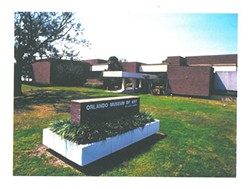A press conference at Orlando Museum of Art last Tuesday, Sept. 29, promised to be fairly straightforward, if not pro forma. The press release advised that OMA director and CEO Glen Gentele and Ted Brown, chairman of the OMA's Strategic Planning Committee, would "discuss the Museum's newly approved goals and institutional vision, including – but not limited to – OMA's presence within Orlando and its surrounding communities."
As a handful of media representatives seated themselves in the SunTrust Auditorium, a constantly looping bit of music was audible. After a couple of minutes, "What is this soundtrack?" one reporter asked; another replied, "It sounds like something ominous is going to happen."
What it was was a loop from Kraftwerk's "Trans-Europe Express," one of the most influential singles ever recorded, a synthy paean to futurism that has become aural shorthand signaling modernity. An apt background, then, for the release of "Forward to 100: Reimagining the Orlando Museum of Art in the 21st Century," the final conclusions of the Board of Trustees' yearlong strategic planning study. That person moved to anxious anticipation by the music wasn't wrong, though. The aura of mystery evoked by the music, if not the press release, resolved itself when Gentele and Brown announced plans to seek a new "container" for the museum's collections.
In other words, as stated on page 33 of the report, "Loch Haven Park is not viewed as the ideal location for the future of the Orlando Museum of Art."
Or, as Brown put it more bluntly a few minutes into his address, "We aren't where we need to be."
Brown said that OMA would seek space in Orlando's "urban core," i.e. downtown, noting that of 65 million annual visitors to Orlando, so few as to be a statistically negligible number visit the museum. The planning board concluded that as public transit options improve and as the Dr. Phillips Center for the Performing Arts becomes more established, Orlando's downtown is the best place to develop a cultural district – something of a knock on Loch Haven, which the city of Orlando website calls "the region's premier cultural park."
"All great cities have great art museums, and we are working in that direction. But relationally, what is around the museum is important," said Gentele.
The museum hopes to increase from its current 19,000 square feet of gallery space to 45,000-50,000 square feet of usable exhibition space, as well as more parking, larger educational facilities, more space for collection vaults and fabrication, a bar and café, a glass-blowing institute and "a five-star restaurant experience," all desires that are incompatible with the current building and land footprint.
Gentele called "Forward to 100" a "vision plan with strategic initiatives." In addition to the goal of a new home, the board wants to focus on more diverse audiences.
"We know ... there are half a million Hispanics that were not here in the '60s and the '70s. We know as well that there's a huge influx of Asian population into Central Florida," Brown said. "That is the future of Orlando, and that is something that we embraced in this report: getting to a place where all of these citizenry come enthusiastically to share in this very unique commodity called art." While museum visitors have apparently been lily-white, the museum has at least made strides in diversifying its exhibitions. Both iterations of the Florida Prize in Contemporary Art, an initiative created on Gentele's watch, have featured an equable mix of male and female artists, with a significant concentration of artists of Hispanic or Latino heritage.
Both Gentele and Brown stressed that this announcement marked the commencement of a yearlong feasibility study, and that within a year they hoped to have a solid plan for what would probably be a 10-year process. Addressing the question of why they would announce their intentions so far ahead of time, Brown said that "the only way to be held accountable to your vision is to tell people your vision ... and we want to be accountable."




